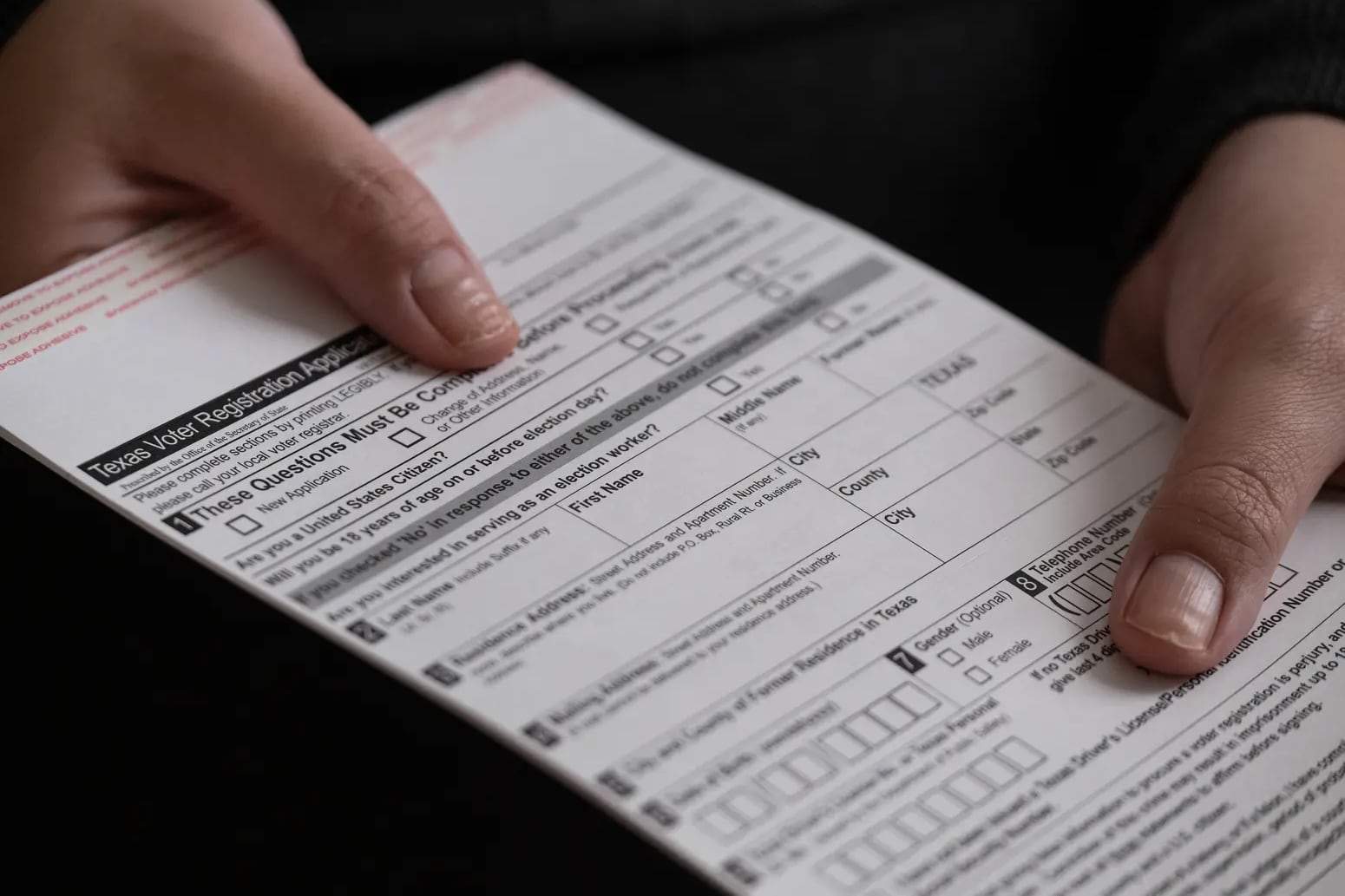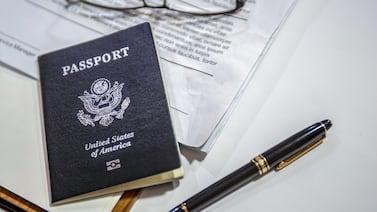This article was first published by The Texas Tribune, a nonprofit, nonpartisan media organization that informs Texans — and engages with them — about public policy, politics, government and statewide issues.
Texas voters have less than a month to register for the Nov. 5 election.
But as county elections officials work to get more people registered, more than 1 million voters have been deemed ineligible. That includes people who moved out of state or are dead — and it’s a routine process.
“We do list maintenance every single day,” said Trudy Hancock, the Elections Administrator for Brazos County. “So you know it’s not something that’s happened just overnight and something that’s been put in place, but it is important to check your registration.”
Gov. Greg Abbott issued a press release last month touting the removal of ineligible voters, claiming some of them were possibly noncitizens. Experts quickly warned the governor’s framing could be used to undermine trust in elections. At the same time, Texas Attorney General Ken Paxton has sued to stop two urban counties from sending voter registration forms to people who are eligible to vote, claiming state law doesn’t allow that kind of outreach and it would risk adding noncitizens to the voter rolls.
Election officials have found no evidence of widespread voting by people who are not citizens in U.S. elections. In 2019, Texas incorrectly flagged 95,000 naturalized citizens for removal from the voter rolls, but backed off those previous removal attempts to settle lawsuits over the matter.
Federal law prevents states from systematically removing registered voters within 90 days of a federal election, though there are some exceptions if the voter has died, been convicted of a felony or been declared mentally incapacitated. Checking your voter registration to make sure it’s active and up to date could save you trouble at the polls. You’ll want to do that before the Oct. 7 deadline to register. It could also help us report on these issues.
Here’s how to check your voter registration. The Texas Tribune, ProPublica and Votebeat want to hear from Texas voters who believe their registrations have been erroneously canceled. Let us know if you find issues with your voter registration through the form at the bottom of this story.
Here's what you need to know
• How do I check if I'm registered to vote? • How are voter registration applications reviewed? • What does it mean if my voter registration is in “suspense”? • How do I register to vote? • What if I registered, but moved after the voter registration deadline? • What do I do if I run into issues with my voter registration?
How do I check if I’m registered to vote?
Once you register to vote, you generally remain registered, but there are various reasons why you may want to verify your registration status, especially if you’ve had a name or address change. You can make those updates online here.
You can check to see if you’re registered and verify your information through the Texas Secretary of State’s website.
You’ll need one of the following three combinations to log in:
- Your Texas driver’s license number and date of birth.
- Your first and last names, date of birth and county you reside in.
- Your date of birth and Voter Unique Identifier Number, which appears on your voter registration certificate.
How are voter registration applications reviewed?
When a person submits a voter registration application, county and state officials verify the person’s eligibility using various sources, including birth and death certificates and the courts system.
Local election officials will review the application to make sure the submitted address is a residential location within the county. They share voter registration records with the state daily. The state also reviews the voter registration before it becomes effective. Registered voters are sent a registration certificate within 30 days and it becomes effective 30 days after it is submitted.
Voters receive a new certificate if they update their name or address. Otherwise, voters are sent a new certificate every two years, according to the state.
What does it mean if my voter registration is in “suspense”?
If a county voter registrar receives a nondeliverable notice after sending a voter registration certificate or receives information that there’s been an address change, a voter is placed on the state’s “suspense list” and asked to confirm their address. Sometimes this can be due to errors at the post office or when a jury summons doesn’t go to the proper address and is returned, said Trudy Hancock, the elections administrator for Brazos County.
Voters on the suspense list can still vote as normal if they update or confirm their address before the voter registration deadline or fill out a “statement of residence” when voting. But if they have moved to a different county or precinct, they may have to vote at their previous polling location or vote a limited ballot.
If a suspended voter takes no action, they are removed from the voter rolls after about four years, according to the Texas Secretary of State’s office.
How do I register to vote?
You must complete and submit a paper voter registration application by Oct. 7.
You can request a postage-paid application through the mail or find one at county voter registrars’ offices and some post offices, government offices, or high schools. You can also print out the online application and mail it to the voter registrar in your county.
Applications must be postmarked by the Oct. 7 deadline. Download your application here.
Additionally, you can register to vote through the Texas Department of Public Safety while renewing your driver’s license. You may be able to register to vote online if you’re also allowed to renew your license online. This is the only form of online registration in the state.
What if I registered, but moved after the voter registration deadline?
You must reside in a Texas county by the voter registration deadline to vote in the upcoming election. Voters who are 65 or older, have a disability or will be absent during the entire voting period, such as members of the military of voters living overseas, qualify for an absentee ballot. You can read more about absentee and mail-in voting here.
If you are a registered voter but moved after the Oct. 7 deadline, you can vote at your previous polling location if you moved within the same county or political subdivision. Or you can vote at your new polling location, but the ballot will only include races available to voters in both your new and old political districts, such as statewide races. Limited ballots are available only during early voting at a “main early voting polling place.” Those are usually the office of the election administrator or county clerk who runs elections in your county. The main polling place should be noted in a county’s list of early voting locations.
What do I do if I run into issues with my voter registration?
If you have questions or concerns about your registration, you can find your county’s voter registration contact here.
Inside polling locations, there are typically “resolution desks” where poll workers can address registration issues. If you believe you should be registered but don’t appear on the voter registration list at the polls, you can cast a provisional ballot. There’s no guarantee that a provisional ballot will ultimately be counted.The best bet to ensure you don’t have problems is verifying your registration is active and up-to-date ahead of the Oct. 7 deadline to register to vote.
Your local voter registrar must review the provisional ballot and verify your registration within six days of the election. The registrar then passes that information to the local ballot board, which decides whether the provisional ballot is eligible to be counted under election laws, according to the Texas Secretary of State’s voter education website.
Provisional voters must be sent a notice about whether their ballot was counted no later than 10 days after the election is certified.
You can also find more information on frequently asked questions from the Secretary of State’s Office at votetexas.gov.
If you need help navigating voting issues, a coalition of voting rights groups has a helpline at 866-687-8683. The Texas Secretary of State’s office has a helpline at 1-800-252-8683.
Disclosure: Texas Secretary of State has been a financial supporter of The Texas Tribune, a nonprofit, nonpartisan news organization that is funded in part by donations from members, foundations and corporate sponsors. Financial supporters play no role in the Tribune’s journalism. Find a complete list of them here.




